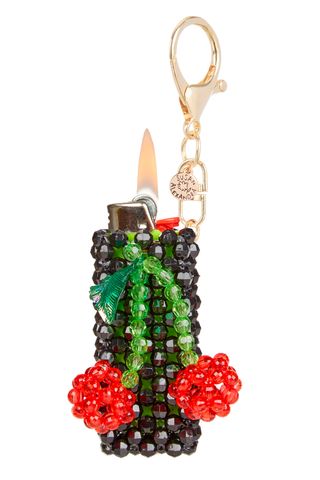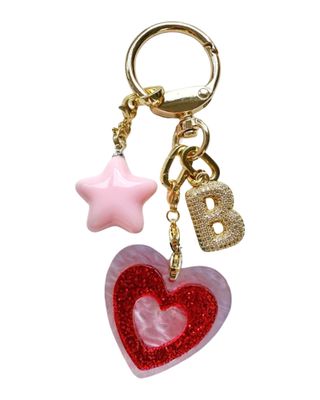The Accessory Micro-Trend Making a Big Comeback in Copenhagen, Paris, and NYC


It's time to stop ignoring the signs. Bag charms are back, baby! Like it or not, we've seen this micro-trend stage a huge comeback on the runway, on the streets, and even online. While it might be easy to pass off bag charms as a silly way younger people can tap into nostalgia surrounding '00s and '10s fashion, there's actually more to the story. You have to keep in mind that all trends exist in the context of everything that came before them, including bag charms. From a historical standpoint, purses have always acted as a visible indicator of social standing, social values, and personal style—that's also true with bag charms.
Although small, bag charms have served as an indicator of society's shifting relationship with luxury. There's no better example of that than this current moment, which shows us that the return of this trend is a microcosm of what's happening in culture. With the rise of the quiet luxury movement, we've seen a mass movement toward minimalism, which has been incredible to witness because we all should be investing in staples for the long term. In the silence, however, we've also come to feel that our focus on the basics has left our style feeling, well, basic. Luckily, the bag-charm trend is ready to fill that void. If you're not sold on why you should be covering the surface of your purse with charms, keep reading.
From the Archives

Bag charms didn't drop straight out of the coconut tree; they've existed for centuries. Historians have widely observed that it was common for people to attach trinkets and talismans to their bags in many ancient civilizations. Bag charms were a way to signify their social class or even a means of spiritual protection. It wasn't until the start of the 21st century that we began to see this trend take on new meaning. Bag charms shifted from being a footnote in the historical margins to being a significant part of the culture—primarily driven by runway collections and style icons.
More specifically, bag charms would not be nearly as popular as they are today without Jane Birkin. The late actress didn't just inspire the Hermès Birkin bag. She turned accessorizing it into a movement. Her signature way of styling her Hermès bag—often overstuffed and covered in silk scarfs, jewelry, stickers, and charms—became so loved that it shifted society's view of luxury then. Fashion became less about buying the buzziest bag of the season and more about personal style, which was most apparent on the runways themselves.
On the Runways
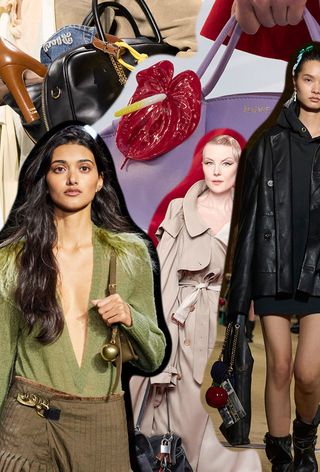
One of the first brands to jump on the bag-charm bandwagon was Hermès. The atelier released the equestrian-inspired Rodeo charms in 2005, which became widely popular overnight. Subsequently, other fashion houses followed suit. For example, Fendi showcased furry monster charms in its F/W 13 collection. There was a time when furry bag charms were inescapable. They were spotted on every star in the 2010s, including Kendall Jenner, Olivia Palermo, and Jennifer Lopez. We might be finally past that awkward stage in the trend, but bag charms themselves aren't done growing. In the last few years, we've seen them slowly evolve into something that feels brand-new.
While most might attribute this accessory's massive growth to Miu Miu's S/S 24 collection (its runway show was brimming with overstuffed bags covered in charms), I'd argue that the seed was planted much sooner. Even before the release of this year's collections, there were other designers embracing bag charms, most notably Loewe. In its S/S 23 collection, the iconic Paseo bag was adorned with a lifelike anthurium charm, foreshadowing this trend's inevitable growth. Loewe inadvertently tapped into what defined this trend from the beginning—letting our lives inspire our luxury goods rather than the other way around.
On the Streets

That ethos has been embodied in even more recent examples of the trend, including Coach's F/W 24 collection. The show featured oversize leather carryalls and quilted shoulder bags adorned with coffee mugs and pretzel-shaped charms, all inspired by New York City. By drawing inspiration from the world around them to create their bag charms, designers have captured the attention of a global audience. Already, we've seen the style set rush to personalize their purses, and Pinterest has reported a 240% jump in searches for bag charms. On TikTok, users have begun to refer to the trend as "Jane Birkin–ifying" their bags. That's all online, not even taking into account how we've already seen so many street style images from Copenhagen, Paris, Milan, London, and New York featuring bag charms.
Basically, there's a lot of buzz surrounding bag charms right now, but it's all well-founded, in my humble opinion. With so many online conversations about luxury fashion championing a minimal and sometimes dull approach to style, this accessory has offered us a much-needed break. The mere act of trying to decenter what's impersonal in lieu of something that speaks to one's personal style takes courage—accessories allow us to do that in small steps. Sure, we may never fully be able to escape the overwhelming desire to shop for new trends and buzzy items, but charms carve out a space for us to make those things our own.
Shop the Trend

Consider opting for a bag with a larger silhouette to give you ample space to add charms.

Take your mini-bag infatuation to the next level with this bag charm.

Since spotting Coach's bag charms on the runway, I've been counting down the days until I could purchase them.

Adopting the "lucky girl syndrome" outlook just got easier thanks to this charm.

Lean into the bag trend's early aughts aesthetic by opting for a bag shape from that era.

I don't eat shellfish, but wearing it? That's a whole different story.

When life hands you lemons, turn them into something charming.

If you style your shoulder bag with this small pretzel charm, you'll look like a snack.

Is it just me, or did this bag charm immediately make you think of Beyoncé singing "I got hot sauce in my bag"?
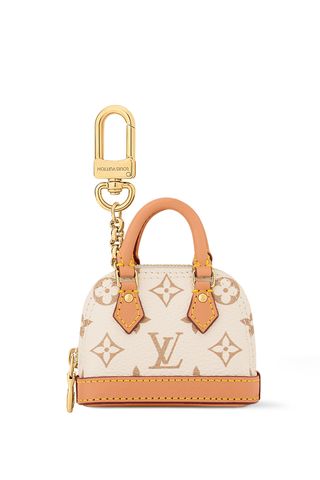
If I were a rich girl, I'd style this mini-bag charm with Louis Vuitton's Nano Speedy bag.
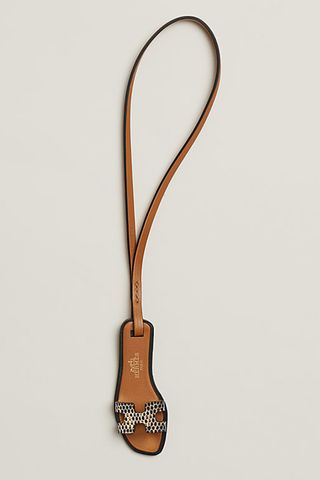
Sandal season may be almost over, but this charm will add a sunnier disposition to your shoulder bag.

Styling tip: When adopting this trend, look for bags that are a bit more minimal to balance out its maximalist-leaning tendencies.

It's a tiny keychain, but it can transport your bag back to the '00s.

It's easy to imagine spotting this charm on a cute bag somewhere in Copenhagen, Montréal, or London.

Just imagine how cool this baguette would look covered in charms.
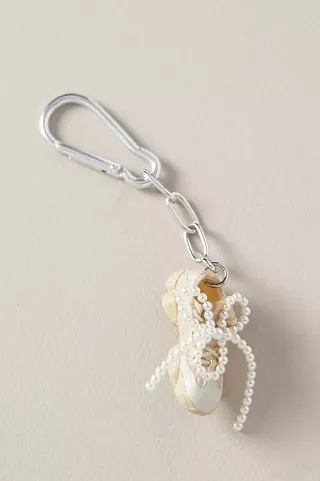
Merge your sneaker collection with your growing charm collection.

Don't be afraid to drape the front of your bag with longer string bag charms.

These little charms look best when layered on a bag with a chain strap.

Of course, Balenciaga would create the easiest way to adopt this trend in one fell swoop.

Jasmine Fox-Suliaman is a fashion editor living in New York City. What began as a hobby (blogging on Tumblr) transformed into a career dedicated to storytelling through various forms of digital media. She started her career at the print publication 303 Magazine, where she wrote stories, helped produce photo shoots, and planned Denver Fashion Week. After moving to Los Angeles, she worked as MyDomaine's social media editor until she was promoted to work across all of Clique's publications (MyDomaine, Byrdie, and Who What Wear) as the community manager. Over the past few years, Jasmine has worked on Who What Wear's editorial team, using her extensive background to champion rising BIPOC designers, weigh in on viral trends, and profile stars such as Janet Mock and Victoria Monét. She is especially interested in exploring how art, fashion, and pop culture intersect online and IRL.
-
 I'm Building My Forever Wardrobe at Harvey Nichols—6 Classic, Autumn-Ready Pieces I'm Considering
I'm Building My Forever Wardrobe at Harvey Nichols—6 Classic, Autumn-Ready Pieces I'm ConsideringSponsor Content Created With Harvey Nichols
By Humaa Hussain
-
 Sienna Miller Just Swapped Her Jeans for Autumn's Biggest Trouser Trend, and Everyone's Going to Copy Her
Sienna Miller Just Swapped Her Jeans for Autumn's Biggest Trouser Trend, and Everyone's Going to Copy HerThis is worth noting.
By Natalie Munro
-
 If You Thought Brown and Burgundy Were Elegant, Wait Until You See Autumn's Newest Colour Trend
If You Thought Brown and Burgundy Were Elegant, Wait Until You See Autumn's Newest Colour TrendYou might be surprised.
By Natalie Munro
-
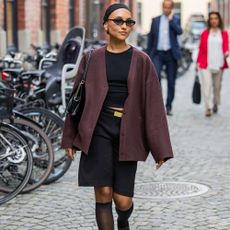 Scandi Style Is My Kryptonite—6 Street Style Trends From Oslo I Can't Stop Thinking About
Scandi Style Is My Kryptonite—6 Street Style Trends From Oslo I Can't Stop Thinking AboutThe ones to know.
By Natalie Munro
-
 I Know You're Stylish If You Already Own This Under-the-Radar, Highly Chic Bag Trend
I Know You're Stylish If You Already Own This Under-the-Radar, Highly Chic Bag TrendIt really does say "I'm in the know".
By Natalie Munro
-
 The Y2K Accessory Trend That Celebrities Are Suddenly Wearing With Jeans and Slip Skirts
The Y2K Accessory Trend That Celebrities Are Suddenly Wearing With Jeans and Slip SkirtsBack at last.
By Natalie Munro
-
 I'm Anti-Heels, But Fashion People in Paris and Milan Are Convincing Me to Try This Comfy Pair
I'm Anti-Heels, But Fashion People in Paris and Milan Are Convincing Me to Try This Comfy PairNew shoe-trend alert!
By Brittany Davy
-
 5 Major Autumn Accessory Trends That Will Still Be Everywhere in 2025
5 Major Autumn Accessory Trends That Will Still Be Everywhere in 2025Wise investments.
By Bébhinn Campbell
-
 Are You Even a Fashion Person If You Don’t Own a Leather Jacket? 5 Fresh Styles I’m Eyeing
Are You Even a Fashion Person If You Don’t Own a Leather Jacket? 5 Fresh Styles I’m EyeingA definitive list.
By Natalie Munro
-
 I Can’t Help Being Bored of My Black Trousers—6 Chic Colours That Feel Much Fresher
I Can’t Help Being Bored of My Black Trousers—6 Chic Colours That Feel Much FresherYour autumn wardrobe will thank you.
By Natalie Munro

